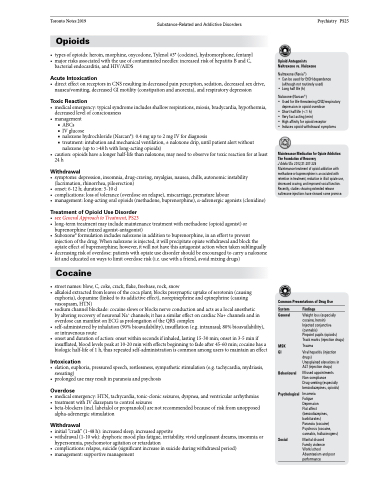Page 1189 - TNFlipTest
P. 1189
Toronto Notes 2019 Substance-Related and Addictive Disorders Opioids
• typesofopioids:heroin,morphine,oxycodone,Tylenol#3®(codeine),hydromorphone,fentanyl
• major risks associated with the use of contaminated needles: increased risk of hepatitis B and C,
bacterial endocarditis, and HIV/AIDS
Acute Intoxication
• directeffectonreceptorsinCNSresultingindecreasedpainperception,sedation,decreasedsexdrive, nausea/vomiting, decreased GI motility (constipation and anorexia), and respiratory depression
Toxic Reaction
• medicalemergency:typicalsyndromeincludesshallowrespirations,miosis,bradycardia,hypothermia, decreased level of consciousness
• management ■ ABCs
■ IVglucose
■ naloxone hydrochloride (Narcan®): 0.4 mg up to 2 mg IV for diagnosis
■ treatment: intubation and mechanical ventilation, ± naloxone drip, until patient alert without
naloxone (up to >48 h with long-acting opioids)
• caution:opioidshavealongerhalf-lifethannaloxone;mayneedtoobservefortoxicreactionforatleast
24h
Withdrawal
• symptoms:depression,insomnia,drug-craving,myalgias,nausea,chills,autonomicinstability (lacrimation, rhinorrhea, piloerection)
• onset:6-12h;duration:5-10d
• complications:lossoftolerance(overdoseonrelapse),miscarriage,prematurelabour
• management:long-actingoralopioids(methadone,buprenorphine),α-adrenergicagonists(clonidine)
Treatment of Opioid Use Disorder
• seeGeneralApproachtoTreatment,PS23
• long-termtreatmentmayincludemaintenancetreatmentwithmethadone(opioidagonist)or
buprenorphine (mixed agonist-antagonist)
• Suboxone®formulationincludesnaloxoneinadditiontobuprenorphine,inanefforttoprevent
injection of the drug. When naloxone is injected, it will precipitate opiate withdrawal and block the
opiate effect of buprenorphine; however, it will not have this antagonist action when taken sublingually
• decreasingriskofoverdose:patientswithopiateusedisordershouldbeencouragedtocarryanaloxone
kit and educated on ways to limit overdose risk (i.e. use with a friend, avoid mixing drugs)
Cocaine
• street names: blow, C, coke, crack, flake, freebase, rock, snow
• alkaloidextractedfromleavesofthecocaplant;blockspresynapticuptakeofserotonin(causing
euphoria), dopamine (linked to its addictive effect), norepinephrine and epinephrine (causing
vasospasm, HTN)
• sodiumchannelblockade:cocaineslowsorblocksnerveconductionandactsasalocalanesthetic
by altering recovery of neuronal Na+ channels; it has a similar effect on cardiac Na+ channels and in
overdose can manifest on ECG as prolongation of the QRS complex
• self-administeredbyinhalation(90%bioavailability),insufflation(e.g.intranasal;80%bioavailability),
or intravenous route
• onsetanddurationofaction:onsetwithinsecondsifinhaled,lasting15-30min;onsetin3-5minif
insufflated, blood levels peak at 10-20 min with effects beginning to fade after 45-60 min; cocaine has a biologic half-life of 1 h, thus repeated self-administration is common among users to maintain an effect
Intoxication
• elation,euphoria,pressuredspeech,restlessness,sympatheticstimulation(e.g.tachycardia,mydriasis, sweating)
• prolongedusemayresultinparanoiaandpsychosis
Overdose
• medicalemergency:HTN,tachycardia,tonic-clonicseizures,dyspnea,andventriculararrhythmias • treatmentwithIVdiazepamtocontrolseizures
• beta-blockers (incl. labetalol or propranolol) are not recommended because of risk from unopposed
alpha-adrenergic stimulation
Withdrawal
• initial“crash”(1-48h):increasedsleep,increasedappetite
• withdrawal(1-10wk):dysphoricmoodplusfatigue,irritability,vividunpleasantdreams,insomniaor
hypersomnia, psychomotor agitation or retardation
• complications: relapse, suicide (significant increase in suicide during withdrawal period)
• management: supportive management
Psychiatry PS25
Opioid Antagonists Naltrexone vs. Naloxone
Naltrexone (Revia®)
• Can be used for EtOH dependence
(although not routinely used) • Long half life (h)
Naloxone (Narcan®)
• Used for life-threatening CNS/respiratory
depression in opioid overdose
• Short half life (<1 h)
• Very fast acting (min)
• High affinity for opioid receptor
• Induces opioid withdrawal symptoms
Maintenance Medication for Opiate Addiction: The Foundation of Recovery
J Addict Dis 2012;31:207-225
Maintenance treatment of opioid addiction with methadone or buprenorphine is associated with retention in treatment, reduction in illicit opiate use, decreased craving, and improved social function. Recently, studies showing extended release naltrexone injections have showed some promise.
Common Presentations of Drug Use
System
General
MSK GI
Behavioural
Psychological
Social
Findings
Weight loss (especially cocaine, heroin) Injected conjunctiva (cannabis)
Pinpoint pupils (opioids) Track marks (injection drugs) Trauma
Viral hepatitis (injection drugs)
Unexplained elevations in ALT (injection drugs)
Missed appointments Non-compliance Drug-seeking (especially benzodiazepines, opioids) Insomnia
Fatigue
Depression
Flat affect
(benzodiazepines, barbiturates)
Paranoia (cocaine) Psychosis (cocaine, cannabis, hallucinogens) Marital discord
Family violence
Work/school
Absenteeism and poor performance


